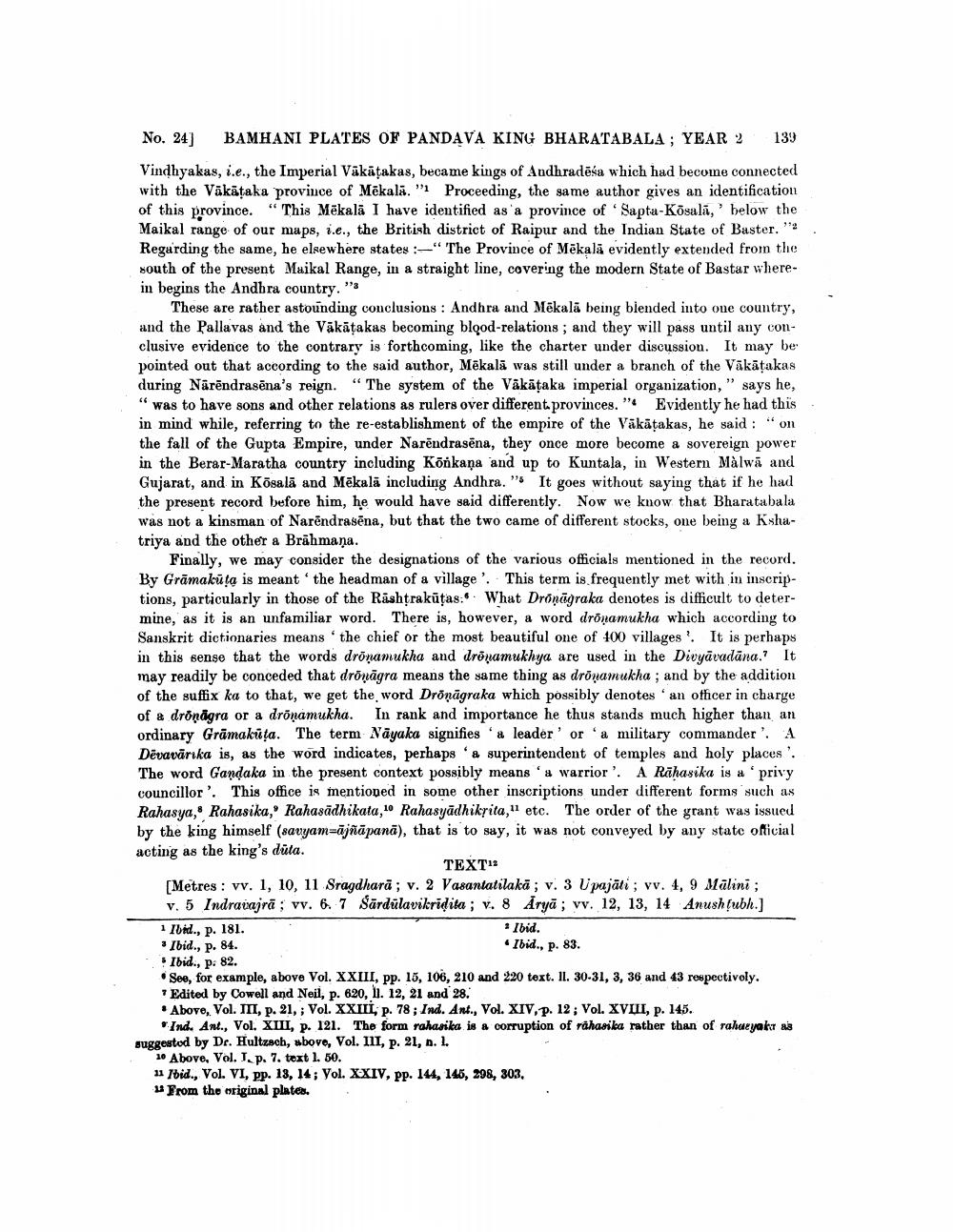________________
No. 24]
BAMHANI PLATES OF PANDAVA KING BHARATABALA; YEAR 2
Vindhyakas, i.e., the Imperial Vākāṭakas, became kings of Andhradeśa which had become connected with the Vākāṭaka province of Mekala. " Proceeding, the same author gives an identification of this province. "This Mēkalā I have identified as a province of Sapta-Kōsala,' below the Maikal range of our maps, i.e., the British district of Raipur and the Indian State of Baster. " Regarding the same, he elsewhere states:-"The Province of Mekala evidently extended from the south of the present Maikal Range, in a straight line, covering the modern State of Bastar wherein begins the Andhra country. "
These are rather astounding conclusions: Andhra and Mekalā being blended into one country, and the Pallavas and the Vākāṭakas becoming blood-relations; and they will pass until any conclusive evidence to the contrary is forthcoming, like the charter under discussion. It may be pointed out that according to the said author, Mēkalā was still under a branch of the Vākāṭakas during Narendrasena's reign. "The system of the Vākāṭaka imperial organization," says he, "was to have sons and other relations as rulers over different. provinces." Evidently he had this
on
in mind while, referring to the re-establishment of the empire of the Vākāṭakas, he said: the fall of the Gupta Empire, under Narendrasēna, they once more become a sovereign power in the Berar-Maratha country including Konkana and up to Kuntala, in Western Malwa and Gujarat, and in Kōsalā and Mēkalā including Andhra." It goes without saying that if he had the present record before him, he would have said differently. Now we know that Bharatabala was not a kinsman of Narendrasena, but that the two came of different stocks, one being a Kshatriya and the other a Brahmana.
139
Finally, we may consider the designations of the various officials mentioned in the record. By Gramakuta is meant the headman of a village'. This term is frequently met with in inscriptions, particularly in those of the Rashtrakutas: What Dronagraka denotes is difficult to determine, as it is an unfamiliar word. There is, however, a word dronamukha which according to Sanskrit dictionaries means the chief or the most beautiful one of 400 villages. It is perhaps in this sense that the words dronamukha and dronamukhya are used in the Divyāvadāna." It may readily be conceded that dronagra means the same thing as dronamukha; and by the addition of the suffix ka to that, we get the word Drōnagraka which possibly denotes an officer in charge of a droṇāgra or a drōnamukha. In rank and importance he thus stands much higher than an ordinary Grāmakūta. The term Nayaka signifies a leader' or a military commander'. A Devavärika is, as the word indicates, perhaps a superintendent of temples and holy places'. The word Gandaka in the present context possibly means a warrior'. A Rahasika is a privy councillor'. This office is mentioned in some other inscriptions under different forms such as Rahasya, Rahasika, Rahasādhikata,10 Rahasyadhikrita," etc. The order of the grant was issued by the king himself (savyam=ājñāpana), that is to say, it was not conveyed by any state official acting as the king's duta.
TEXT12
[Metres: vv. 1, 10, 11 Sragdhara; v. 2 Vasantatilakā; v. 3 Upajāti; vv. 4, 9 Mālinī; v. 5 Indravajrā; vv. 6. 7 Sārdulavikridita; v. 8 Arya; vv. 12, 13, 14 Anushṭubh.]
2 Ibid.
1 Ibid., p. 181. Ibid., p. 84.
Ibid., p. 82.
See, for example, above Vol. XXIII, pp. 15, 106, 210 and 220 text. II. 30-31, 3, 36 and 43 respectively. Edited by Cowell and Neil, p. 620, 11. 12, 21 and 28.
Above, Vol. III, p. 21,; Vol. XXIII, p. 78; Ind. Ant., Vol. XIV, p. 12; Vol. XVIII, p. 145.
Ind. Ant., Vol. XIII, p. 121. The form rahasika is a corruption of rahasika rather than of rahaɛyaka as suggested by Dr. Hultzsch, above, Vol. III, p. 21, n. 1.
10 Above, Vol. J. p. 7. text 1. 50.
11 Ibid., Vol. VI, pp. 13, 14; Vol. XXIV, pp. 144, 145, 298, 303,
12 From the original plates.
Ibid., p. 83.




